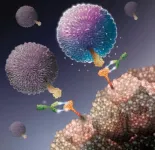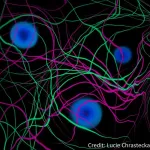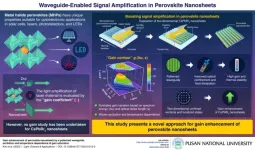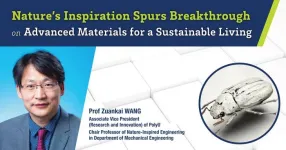(Press-News.org) (Boston)—While musculoskeletal imaging volumes are increasing, there is a relative shortage of subspecialized musculoskeletal radiologists to interpret the studies. Is AI the solution?
“With the ongoing trend of increased imaging rates and decreased acquisition times, a variety of AI tools can support musculoskeletal radiologists by providing more optimized and efficient workflows,” says corresponding author Ali Guermazi, MD, PhD, chief of radiology at VA Boston Healthcare System and professor of radiology and medicine at Boston University Chobanian & Avedisian School of Medicine.
In a new article in the journal Radiology, BU researchers provide an overview of AI applications for musculoskeletal radiology, including basic principles, image acquisition and interpretation, and prediction of future outcomes. Their article also discusses AI implementation challenges, the non-interpretive uses of AI and how it may transform the daily professional lives of musculoskeletal radiologists.
According to the researchers, AI shows great potential for more complex tasks such as disease prognostication and prediction of clinical outcomes over time, which may increase the value of imaging and allow the field to take a big step forward toward precision medicine.
However, many challenges need to be overcome for AI to make its way to clinical practice. These include the requirement for large, good-quality data sets, which is more problematic for uncommon conditions such as musculoskeletal tumors, among others. They point out that multi-institutional collaboration will be essential to the creation of such data sets, but this introduces issues of its own such as differences in imaging protocols.
“For AI to be the solution, the wide implementation of AI-supported data acquisition methods in clinical practice requires establishing trusted and reliable results. This implementation will require close collaboration between core AI researchers and clinical radiologists,” says Guermazi.
Upon successful clinical implementation, a wide variety of AI-based tools can improve the musculoskeletal radiologist’s workflow. Additional AI applications also may be helpful for business, education and research purposes if successfully integrated into the daily practice of musculoskeletal radiology.
Guermazi reassures that AI will not replace radiologists, but rather radiologists in the future will all use AI.
END
Can artificial intelligence (AI) improve musculoskeletal imaging?
AI-based tools can improve the musculoskeletal radiologist’s workflow by triaging imaging examinations, helping with image interpretation and decreasing the reporting time
2024-01-03
ELSE PRESS RELEASES FROM THIS DATE:
Case Western Reserve researchers land $1.125 million National Science Foundation grant to advance safer, faster and less expensive medical-imaging technology
2024-01-03
CLEVELAND—Diagnosing cancer today involves using chemical “contrast agents” to improve the accuracy of medical imaging processes such as X-rays as well as computed tomography (CT) and magnetic resonance imaging (MRI) scans.
But those agents can be expensive, take more time to use and pose potential health concerns.
With a new four-year, $1.125 million grant from the National Science Foundation (NSF), researchers at Case Western Reserve University hope to develop an artificial intelligence (AI) alternative ...
PTSD: the brain basis of susceptibility - a free webinar from the Brain & Behavior Research Foundation
2024-01-03
The Brain & Behavior Research Foundation (BBRF) is hosting a free webinar, “PTSD: The Brain Basis of Susceptibility” on Tuesday, January 9, 2024, at 2:00 pm ET. The presenter will be Nathaniel G. Harnett, Ph.D., Director of the NATE Lab at McLean Hospital and Assistant Professor in Psychiatry at Harvard Medical School. Dr. Harnett is also the recipient of a 2021 Young Investigator Grant. The webinar will be hosted by Jeffrey Borenstein, M.D., President & CEO of the Brain & Behavior Research Foundation, and host of the public television series Healthy Minds.
Register today ...
Knowing how clinicians make real-world decisions about drug-drug interactions can improve patient safety
2024-01-03
INDIANAPOLIS — Drug-drug interactions causing adverse effects are common and can cause significant patient harm and even death. A new study is one of the first to examine how clinicians become aware of and process information about potential interactions and subsequently make their real-world decisions about prescribing. Based on these findings, the research team makes specific recommendations to aid clinician decision-making to improve patient safety.
“Drug-drug interactions are very common, more common than a lot of people outside the healthcare system expect. In the U.S., these interactions lead to hundreds of thousands of hospitalizations ...
Immune cell helps predict skin cancer patients’ chances of responding to treatment
2024-01-03
A type of immune cell can help predict which patients may benefit most from cancer immunotherapies, researchers from King’s College London, Guy’s and St Thomas’ Hospital Trust, and the Francis Crick Institute have found.
The study, published today in Nature Cancer, found that a rare type of T cells (a type of immune cell), can help predict the likelihood of whether a patient with advanced skin cancer will be responsive to immunotherapy treatments. The results could also lead to the development of new and more effective treatments for patients with melanoma who do not benefit from current ...
Reprogrammed fat cells support tumor growth
2024-01-03
Mutations of the tumor suppressor p53 not only have a growth-promoting effect on the cancer cells themselves, but also influence the cells in the tumor's microenvironment. Scientists at the German Cancer Research Center (DKFZ) and the Weizmann Institute in Israel have now shown that p53-mutated mouse breast cancer cells reprogram fat cells. The manipulated fat cells create an inflammatory microenvironment, impairing the immune response against the tumor and thus promoting cancer growth.
No other gene is mutated as frequently in human tumors as the gene for the tumor suppressor p53. In around 30 percent of all cases of breast cancer, the cancer cells show mutations or losses ...
Early primates likely lived in pairs
2024-01-03
Primates – and this includes humans – are thought of as highly social animals. Many species of monkeys and apes live in groups. Lemurs and other Strepsirrhines, often colloquially referred to as “wet-nosed” primates, in contrast, have long been believed to be solitary creatures, and it has often been suggested that other forms of social organization evolved later. Previous studies have therefore attempted to explain how and when pair-living evolved in primates.
More recent research, however, indicates that many nocturnal Strepsirrhines, which are more challenging to investigate, are not in fact solitary but live in pairs of males and females. But ...
Foundation laid for improved diagnostic imaging of brain tumors
2024-01-03
Research team draws up criteria for PET-based examinations of malignant brain tumors
Diffuse gliomas are malignant brain tumors that cannot be optimally examined by means of conventional MRI imaging. So-called amino acid PET scans are better able to image the activity and spread of gliomas. An international team of researchers (RANO Working Group), led by scientists from LMU and the Medical University of Vienna, has now drawn up the first ever international criteria for the standardized imaging of gliomas using amino acid PET. It has published its results ...
Magnetic fields in the Cosmos: dark matter could help us discover their origin
2024-01-03
The mini-halos of dark matter scattered throughout the Cosmos could function as highly sensitive probes of primordial magnetic fields. This is what emerges from a theoretical study conducted by SISSA and published in Physical Review Letters. Present on immense scales, magnetic fields are found everywhere in the Universe. However, their origin are still subjects of debate among scholars. An intriguing possibility is that magnetic fields originated near the birth of the universe itself, that is they are primordial magnetic fields. In the study, researchers showed that if magnetic fields are indeed primordial then it could cause an increase in dark matter density perturbations ...
Pusan National University researchers boost signal amplification in perovskite nanosheets
2024-01-03
Perovskite materials are still attracting a lot of interest in solar cell applications. Now, the nanostructures of perovskite materials are being considered as a new laser medium. Over the years, light amplification in perovskite quantum dots has been reported, but most of the works present inadequate quantitative analysis. To assess the light amplification ability, “gain coefficient” is necessary, whereby the essential characteristic of a laser medium is revealed. An efficient laser medium is one that has a large gain.
Scientists have been exploring ways to boost this gain. Now, in a recent study, a team of researchers, led by Professor ...
PolyU researchers develop nature-inspired advanced materials to achieve 99.6% solar reflectivity
2024-01-03
Scientific researchers draw inspiration from nature’s brilliance as they seek to develop transformative solutions to unresolved challenges. Prof. WANG Zuankai, Associate Vice President (Research and Innovation) and Chair Professor of the Department of Mechanical Engineering of The Hong Kong Polytechnic University (PolyU), has meticulously explored the intricacies of nature and made remarkable findings with very significant real-world applications. His recently published research on cooling ceramic successfully translates novel discovery into sustainable applications.
Findings from his research project “Hierarchically structured passive radiative cooling ceramic with high ...
LAST 30 PRESS RELEASES:
Researchers use robotics to find potential new antibiotic among hundreds of metal complexes
Gut bacteria changes at the earliest stages of inflammatory bowel disease
Scientists develop new way to “listen in” on the brain’s hidden language
Brain research: “Pulse generators” grow and shrink as memories are formed
For teens, any cannabis use may have impact on emotional health, academic performance
School meals could unlock major gains for human and planetary health
Menopause hormone therapy does not appear to impact dementia risk
Signature patterns of brain activity may help predict recovery from traumatic brain injury
Dresden study uncovers new key mechanism in cancer cells
New species are now being discovered faster than ever before, study suggests
Cannabis-based products show limited short-term benefit for chronic pain, with increased risk of adverse effects
Cannabis products with more THC slightly reduce pain but cause more side effects
Clearing the brain of aging cells could aid epilepsy and reduce seizures
Brain injuries linked with potential risk of suicide, new study finds
New technique lights up where drugs go in the body, cell by cell
New study finds movement of fishing fleets can reveal shifts in marine ecosystems
Embargoed: New evidence points to potential treatment for vascular dementia
Study uncovers disrupted brain balance in alcohol dependence
Working in groups can help Republicans and Democrats agree on controversial content moderation online
Structural findings reveal how distinct GPCR ligands create different levels of activation
Anything-goes “anyons” may be at the root of surprising quantum experiments
UC review: Maximizing workplace opportunity for veterans
From generation to complex control: Metasurfaces make perfect vortex beams "within reach"
Thin-film lithium niobate-based detector: recent advances and perspectives
Exploring why some people may tend to persistently make bad choices
How cells balance their protein levels
Nirsevimab vs RSVpreF vaccine for RSV–related hospitalization in newborns
Effectiveness and impact of maternal RSV immunization and nirsevimab on medically attended RSV in US children
AI gives scientists a boost, but at the cost of too many mediocre papers
Next-generation vision model maps tree growth at sub-meter precision
[Press-News.org] Can artificial intelligence (AI) improve musculoskeletal imaging?AI-based tools can improve the musculoskeletal radiologist’s workflow by triaging imaging examinations, helping with image interpretation and decreasing the reporting time





